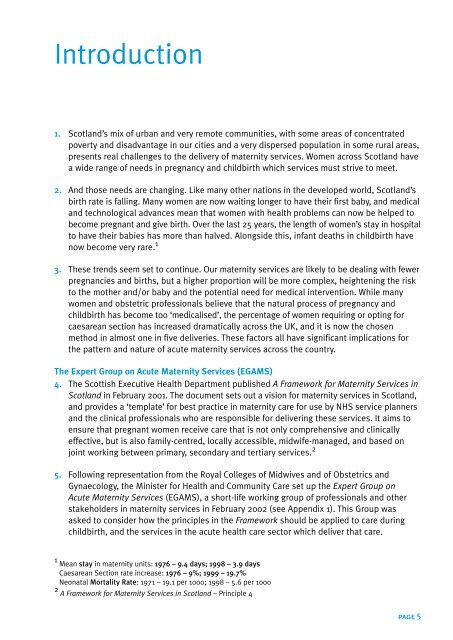Implementing A Framework for Maternity ... - Scottish Government
Implementing A Framework for Maternity ... - Scottish Government
Implementing A Framework for Maternity ... - Scottish Government
You also want an ePaper? Increase the reach of your titles
YUMPU automatically turns print PDFs into web optimized ePapers that Google loves.
Introduction<br />
1. Scotland’s mix of urban and very remote communities, with some areas of concentrated<br />
poverty and disadvantage in our cities and a very dispersed population in some rural areas,<br />
presents real challenges to the delivery of maternity services. Women across Scotland have<br />
a wide range of needs in pregnancy and childbirth which services must strive to meet.<br />
2. And those needs are changing. Like many other nations in the developed world, Scotland’s<br />
birth rate is falling. Many women are now waiting longer to have their first baby, and medical<br />
and technological advances mean that women with health problems can now be helped to<br />
become pregnant and give birth. Over the last 25 years, the length of women’s stay in hospital<br />
to have their babies has more than halved. Alongside this, infant deaths in childbirth have<br />
now become very rare. 1<br />
3. These trends seem set to continue. Our maternity services are likely to be dealing with fewer<br />
pregnancies and births, but a higher proportion will be more complex, heightening the risk<br />
to the mother and/or baby and the potential need <strong>for</strong> medical intervention. While many<br />
women and obstetric professionals believe that the natural process of pregnancy and<br />
childbirth has become too ‘medicalised’, the percentage of women requiring or opting <strong>for</strong><br />
caesarean section has increased dramatically across the UK, and it is now the chosen<br />
method in almost one in five deliveries. These factors all have significant implications <strong>for</strong><br />
the pattern and nature of acute maternity services across the country.<br />
The Expert Group on Acute <strong>Maternity</strong> Services (EGAMS)<br />
4. The <strong>Scottish</strong> Executive Health Department published A <strong>Framework</strong> <strong>for</strong> <strong>Maternity</strong> Services in<br />
Scotland in February 2001. The document sets out a vision <strong>for</strong> maternity services in Scotland,<br />
and provides a ‘template’ <strong>for</strong> best practice in maternity care <strong>for</strong> use by NHS service planners<br />
and the clinical professionals who are responsible <strong>for</strong> delivering these services. It aims to<br />
ensure that pregnant women receive care that is not only comprehensive and clinically<br />
effective, but is also family-centred, locally accessible, midwife-managed, and based on<br />
joint working between primary, secondary and tertiary services. 2<br />
5. Following representation from the Royal Colleges of Midwives and of Obstetrics and<br />
Gynaecology, the Minister <strong>for</strong> Health and Community Care set up the Expert Group on<br />
Acute <strong>Maternity</strong> Services (EGAMS), a short-life working group of professionals and other<br />
stakeholders in maternity services in February 2002 (see Appendix 1). This Group was<br />
asked to consider how the principles in the <strong>Framework</strong> should be applied to care during<br />
childbirth, and the services in the acute health care sector which deliver that care.<br />
1 Mean stay in maternity units: 1976 – 9.4 days; 1998 – 3.9 days<br />
Caesarean Section rate increase: 1976 – 9%; 1999 – 19.7%<br />
Neonatal Mortality Rate: 1971 – 19.1 per 1000; 1998 – 5.6 per 1000<br />
2 A <strong>Framework</strong> <strong>for</strong> <strong>Maternity</strong> Services in Scotland – Principle 4<br />
page 5

















